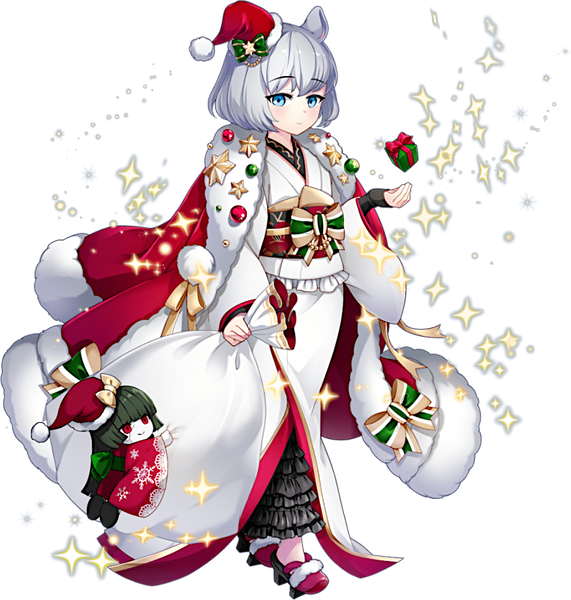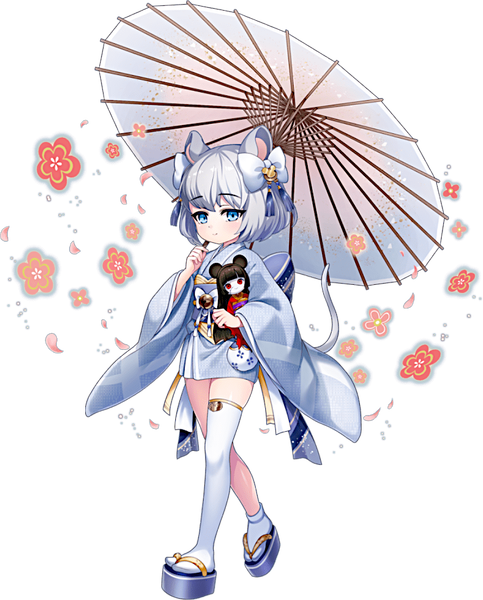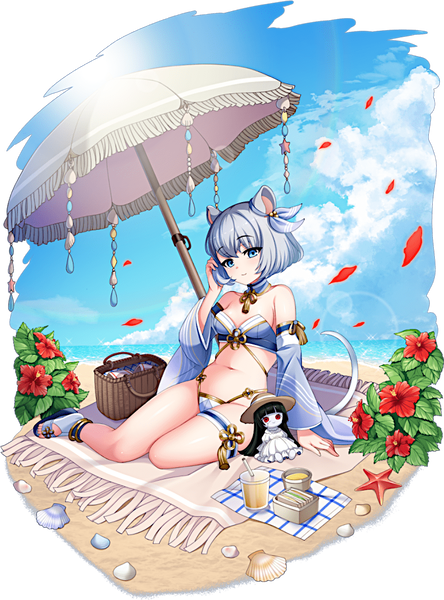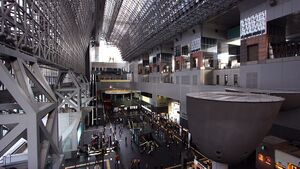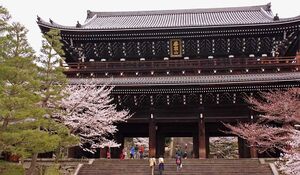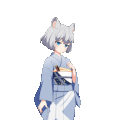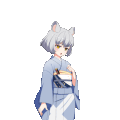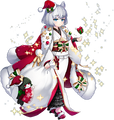Yuuzen
| Yuuzen | |||||
|---|---|---|---|---|---|
| Japanese Name | ユウゼン | ||||
| Weapon | |||||
| Race | Beast | ||||
| Nationality | |||||
| Birthday | February 6 | ||||
| Constellation | Aquarius | ||||
| Talents | Making dolls, Sorcery | ||||
| Likes | Dolls | ||||
| Dislikes | People who mistreat dolls, Overly-familiar people | ||||
| Strengths | Patient, Courageous | ||||
| Weaknesses | Does not try to get on well with others | ||||
| Hobbies | Playing with dolls | ||||
Yuuzen. Guess that means I am part of the Nishiki army? Military uniforms are just for decoration. I live only for my purpose. My task is to find the works of Yuuzen the First. Assistance for the SSS is merely my side project. I won't listen to yer orders. Don't forget that.
Layers
| Icon | Title | Release Date | Where to Obtain |
|---|---|---|---|
| [Doll Master Sorceress] Yuuzen | 2022 September 22 | [Altar of Judgement - Slaking] Event Reward | |
| [Dolls and Merii Kurisumasu] Yuuzen | 2022 December 15 | [It's a Gift for the Holy Night♪] Limited Gacha | |
| [Together With Doll-san] Yuuzen | 2024 May 1 | [Little Lady Predator] Event Reward | |
| [Counting Up Piled Up Thoughts] Yuuzen | 2022 September 22 | 2nd Anniversary Limited Gacha 2 | |
| [Puppeteer at the Shore] Yuuzen | 2023 July 14 | [Seaweed Liquor and Pineapple Bread] Limited Gacha |
Skills
Profile
Main Story
| Story Arc 1 |
|---|
|
Yuuzen is one of the executives of the Resistance, who self-proclaims as an ordinary doll vendor. Nicknamed "Kekkai Yaburi" meaning Barrier Buster, Yuuzen has been labelled a dangerous menace by the country of Nishiki by causing more Phantom Mist to spread around the country. She claims her actions actually protects their lands better, as the monsters are never able to enter the country's enchanted main entrance in the first place and things will revert back to normal. She shares the same name with Yuuzen the First, the original doll master. She makes her first appearance in the Nishiki Saga (chapter 3), pretending to be a regular doll seller, offering to sell Vivienne some of her wares for cheap, though Yoshino noticed the dolls are cursed and kindly declined her offer. Shrugged, she left. The next time they meet her again was Yuuzen breaking the barriers at the peak of the mountain in Nishiki to release more Phantom Mist, her actions seemingly insane to the SSS. She demonstrated her potent magical ability by using mass body-binding magic, which is illegal sorcery in Nishiki to be used on people. She was scared off after Ohana's Tsukiyo Banshuu came to the rescue. Meeting up with Queenrose, she half-jeered Yuuzen for being so restless, but acknowledged that she's running away from the real danger that is Ohana, daughter of Shibazakura, the former God of War, for if either of them dueled her, one of them would legitimately die. Yuuzen's last moment in the first story arc was her self-sacrifice, rescuing Mary from Canaria's grasp, by strangling Canaria by surprise from behind. Canaria retorted and seethed angrily, as Yuuzen is the most hated woman she's ever met. Yuuzen counter-sneered, telling her they'll both stay in Hell just as she wanted Mary to stay with her. With a final, hard push of magic, Yuuzen got Mary into the receding magical Gate in the nick of time, greeting Mary farewell. Mary thanked Yuuzen's sacrifice, saying she'll make a visit to Yuuzen's dolls after this as gratitude. On the final moments of Ricardo Trevithick's battle against the SSS, the team managed to view Yuuzen in Ricardo's flashback where she introduced Yuuzen into her Resistance team. Yuuzen greeted Mary and wondered why she's part of the Resistance, but Mary brushed it off, and said to just pretend she went AWOL inside the Mist and never returned. Ricardo introduced to Mary that Yuuzen is the descendant of the legendary doll master Yuuzen I. Yuuzen downplayed her status, saying since nobody would believe her anyway, and there's too many copycats. Though both Ricardo and Mary believed her completely, as both are able to sense the incredible powers the dolls possess in her basket, and her actions to save a child's doll in the Phantom Mist prove her as the real deal. Yuuzen stated she doesn't care what others think of her and she doesn't help people because she expected favors in return - exactly values that Ricardo wanted. When Mary brought up the subject of Ricardo's son the Conductor, Yuuzen is surprised to know she has a son and even more dismayed that she brings her son around to dangerous missions on the Mist Train, though Ricardo calls that her parenting methods. |
Trivia
- Yuuzen's birthday is the opening date of Kyoto Station in 1877. The Yūzen dye method originated from Kyoto.
- Yuuzen's beast motif is the rat, likely based on the komanezumi famous in the Otoyo Shrine in Sakyo-ku, Kyoto. Komanezumi is a stone rat variant of the guardian stone dogs, komainu.
- The name origin for "Yuuzen" (友禅染) is a Japanese resist dyeing technique where dyes are applied inside outlines of dyed or undyed rice-paste resist, which may be drawn freehand or stenciled; the paste keeps the dye areas separated. The technique was named after Miyazaki Yūzen, a 17th century fan painter who made the technique widespread later. Miyazaki Yūzen is known to live in Chion-in Temple.
- As a Resistance executive, the faction emblem is marked on the bottom half of Yuuzen's kimono in white.
- Formerly a Resistance executive, Yuuzen is Miyako's unofficial teacher on advanced sorcery since Iris Metro Arc, excelling in the very difficult "Counting Curse" technique (数え呪詛), where the curses are re-casted to stack up the intensity of said magic to be released, ranging from curse numbers One until Ten. Only a few sorcerers and sorceresses know counting curse, and this art damages the caster depending on the level. The caster dies after counting to Curse Ten, but no known sorcerer or sorceress has ever reached that stack.
- The doll Yuuzen holds is the Miyabihime, one of Yuuzen the First's creations. Miyabihime is the predecessor to Nene and Nana of Yumiharizuki.
- The building in the background of [Counting Up Piled Up Thoughts] is either the Chion-in Temple new gate (知恩院新門), or the Hamaguri-Gomon Gate (蛤御門), one of the nine gates of Kyoto Gyoen National Garden in Kyoto. Yuuzen-en (Yuuzen Garden) is inside Chion-in.
Counterpart
Kyōto Station (京都駅) is a major railway station and transportation hub in Kyōto, Japan. It has Japan's second-largest station building (after Nagoya Station) and is one of the country's largest buildings, incorporating a shopping mall, hotel, movie theater, Isetan department store, and several local government facilities under one 15-story roof. It also housed the Kyōto City Air Terminal until August 31, 2002.
The station has a side platform and four island platforms serving eight tracks for the Tokaido Line (Biwako Line, JR Kyoto Line) and Kosei Line at ground level, three dead-end platforms serving four tracks for the Sanin Line (Sagano Line) to the west of platform 0 at ground level, and two dead-end platforms serving 3 tracks to the south of platform 7 at ground level. Two island platforms serving four tracks for the Shinkansen are elevated, above the platforms for the Kintetsu Kyoto Line.
The governmental railway from Kobe reached Kyoto on September 5, 1876, but the station was under construction and a temporary facility called Ōmiya-dōri (Ōmiya Street) Temporary Station was used until the opening of the main station. The first Kyoto Station opened for service by decree of Emperor Meiji on February 5, 1877. In 1889, the railway became a part of the trunk line to Tokyo (Tokaido Main Line). Subsequently, the station became the terminal of two private railways, Nara Railway (1895, present-day Nara Line) and Kyoto Railway (1897, present-day Sagano Line), that connected the station with southern and northern regions of Kyoto Prefecture, respectively.
The station was replaced by a newer, Renaissance-inspired facility in 1914, which featured a broad square (the site of demolished first station) leading from the station to Shichijō Avenue. This station burned to the ground in 1950, and was replaced by a more utilitarian concrete facility in 1952. The current Kyoto Station opened in 1997, commemorating Kyoto's 1,200th anniversary. It is 70 meters high and 470 meters from east to west, with a total floor area of 238,000 square meters. Architecturally, it exhibits many characteristics of futurism, with a slightly irregular cubic façade of plate glass over a steel frame. The architect was Hiroshi Hara. Wikipedia
Chion-in (知恩院, Monastery of Gratitude) in Higashiyama-ku, Kyoto, Japan is the headquarters of the Jōdo-shū (Pure Land Sect) founded by Hōnen (1133–1212), who proclaimed that sentient beings are reborn in Amida Buddha's Western Paradise (Pure Land) by reciting the nembutsu, Amida Buddha's name. The vast compounds of Chion-in include the site where Hōnen settled to disseminate his teachings and the site where he died.
The original temple was built in 1234 by Hōnen's disciple, Genchi (1183–1238) in memory of his master and was named Chion-in. While the temple was affiliated more closely in the early years with the Seizan branch of Jodo Shu, its 8th head priest, Nyoichi (1262–1321) was deeply influenced by the priest Ryōkū, a disciple of Ryōchū who was the 3rd head of the Chinzei branch of Jōdo-shū Buddhism, and disciple of Benchō. By 1450, Chion-in had become fully under control of the Chinzei branch, but had little direct control, due to the outbreak of the Ōnin War. Numerous buildings in the complex were burnt down in 1633, but were entirely rebuilt by the third Tokugawa shōgun Iemitsu (1604–1651) with the palatial structures that stand today. Wikipedia
The Yūzen'en Garden was redesigned in 1954 in commemoration of the 300th birthday of Miyazaki Yūzen, the founder of the Yūzen style of dyeing. This is a famous modern garden which consists of two gardens: one that draws water from a Higashiyama spring and one in the karesansui (dry rock garden) style. Inside the garden, there are two teahouses: the first is Karoku-an, which is modeled after an Urasenke-style teahouse, and the Hakuju-an, which was built in commemoration of the 99th birthday of Nakamura Kōryū, the 86th chief high priest of the Chion-in. These teahouses add a touch of taste fitting of a famous garden that represents the heart of Japan. Chion-in
Map
Gallery
- Pages using Tabber parser tag
- Pages using DynamicPageList3 parser tag
- Weapon Artifact
- Beast
- Nishiki
- Aquarius
- Element Cut
- Element Dark
- Element Fire
- Train Knights
- Resistance
- Japan


